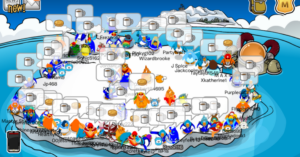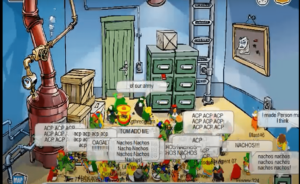History thrives on rivalries, the paradox of unity and division shaping the legacies of Club Penguin Armies. From territorial clashes to leadership struggles, these battles have defined tactics, triumphs, and the community’s identity. In this edition of Picture Perfect, we explore the iconic rivalries that shaped the spirit and legacy of Club Penguin Armies.

Designed by Cassie
DORITOS AND ICE WARRIORS
The Ice Warriors, created by Iceyfeet1234 in June 2007, had already become one of Club Penguin’s most potent armies years before the formation of the Doritos of Club Penguin. In December 2007, they strengthened their ranks by merging with the Dark Warriors. Several other armies came together to form The Warriors Army (TWA), but internal strife caused it to disband. A rebellion inside IW endangered Iceyfeet1234’s leadership in 2008, but the army recovered and began its Golden Age, solidifying IW’s position as a dominant force in the community.

Doritos history page mentioning the winner of the ” DCP ‘ abbreviation.

ACP troops competing with Doritos
Wwebestfan launched the Doritos of Club Penguin on February 8, 2010, and it gained popularity fast, with more than 40 members joining in a matter of days. The Defense of Club Penguin, an amateur army, first challenged the Doritos for the acronym “DCP.” However, the Doritos ultimately prevailed and secured the moniker. In a short-lived conflict, DCP and the Army of Club Penguin engaged in significant combat over Vanilla and Sparkle servers. ACP eventually captured Sparkle and incorporated it into their domain, even though DCP had conquered Vanilla. Nevertheless, a solid alliance was created between the two forces, and DCP was ranked among the Top 10.

ACP and DCP troops battling in Vanilla and Sparkle.
The Rise of a Rivalry

Doritos Invasion of Snowcap
Watersheds and Wars
The rivalry between the Ice Warriors and Doritos peaked in 2015, a year marked by intense conflict. By then, the Doritos had rebounded from a slump to reclaim dominance, while the Ice Warriors thrived in tournaments like March Madness and Legends Cup VIII. Following DCP’s loss in March Madness and escalating raids, war was declared in March, with servers like Summit and Freezer becoming key battlegrounds. IW largely outmaneuvered DCP, securing decisive victories and exploiting Doritos’ no-shows, though some skirmishes ended inconclusively. The conflict resumed in September but saw minimal direct battles, as both sides focused on expanding their territories. A negotiated settlement ended the war, reflecting mutual respect’s strength and influence.

Battle between Doritos and Ice Warriors in CPAC’s Legends Cup Quarter-finals
Beyond the CPPS Era

War declaration proposed by IW against Doritos
After Club Penguin’s closure in 2017, both armies briefly disbanded but reformed in 2019 for the Club Penguin Online Army League, reigniting their rivalry. This resurgence saw unprecedented growth, with monumental battles involving over 150 penguins. By early 2020, the Ice Warriors, Dark Warriors, and Templars allied against DCP, leading to fierce but unresolved conflicts. Despite their resilience, DCP faced severe defeats and disbanded in late 2020 after forming the Black Ice Alliance, ending their rivalry. Their history highlights the competitive spirit of Club Penguin armies, inspiring future generations. Notably, Doritos and Ice Warriors also clashed in tournaments like March Madness 2020 and Christmas Chaos.

DCP and IW competing in March Madness 2020

DCP and IW competing in Christmas Chaos 2020
REBEL PENGUIN FEDERATION AND UNDERGROUND MAFIA ARMY
The rivalry between the Rebel Penguin Federation and the Underground Mafias Army is one of the most significant in Club Penguin Army history, with critical confrontations and ideological differences. The antagonism began in January 2007 when Pink Mafias founded UMA, an army known for its domination and questionable reputation as a result of charges of manipulating Club Penguin’s mechanics. UMA’s early campaigns against the Army of Club Penguin cemented its reputation as a powerful army.
However, according to the RPF history page, this era also planted the seeds of dissension, as Commando717, a major UMA staff member, became disillusioned with the organization’s tactics and abuses. Commando717 founded the Rebel Penguin Federation in May 2007, utilizing his leadership inside UMA’s Blue Mafia branch. The organization swiftly rose to popularity and emerged as a direct rival to UMA’s dominance.

A battle taking place between UMA and ACP
EMERGING CONFLICTS
The struggle between RPF and UMA grew throughout multiple wars, most notably World War III when RPF joined forces with the Army of Club Penguin and the Club Penguin Air Force to defeat UMA at Wool Socks. UMA’s collapse proceeded with internal strife and disputes, concluding with Pink Mafias’ exclusion from Club Penguin. Despite this, the rivalry erupted anew in 2009, when UMA successfully raided many RPF servers, notably Tuxedo and Summit, resulting in RPF’s first significant setback. The rivalry took another turn in the 2013 Legends Cup, when RPF won the event, confirming their strength as they focused on defeating other opponents. Meanwhile, UMA, distracted by many disputes, did not engage in big battles at the time.

Battle taking place between Rebels and UMA

A fictional map of Club Penguin at the end of World War Three
The rivalry resurfaced during the Club Penguin Private Server era, when UMA, renamed the Romans, allied with the Dark Knight Empire and Tubas against RPF. Despite wars like the War of Roman Subjugation, both forces faced internal challenges. Rebel Penguin Marines, a faction created by unhappy RPF troops, attempted to regain control under Elmikey’s leadership but eventually collapsed due to internal conflicts and hacks. By 2021, UMA had ceased operations, and RPF had emerged as one of the community’s greatest and most powerful armies. The competition between RPF and UMA, while no longer active, left an indelible mark on the history of Club Penguin Armies.
NACHOS AND ARMY OF CLUB PENGUIN
The rivalry between the Army of Club Penguin and the Nachos is one of the most heated and historically significant in the realm of Club Penguin Armies. This long-running war originated in 2006 when both groups sprang from the original Reds and Blues clans that had formed in response to the early Color Wars, commonly known as World War I. The Army of Club Penguin, created by Oagalthorp, the founding father of Club Penguin Armies on September 29, 2006, swiftly gained supremacy in the Miniclip forums, while the Nachos began as rogue clans. However, under Tom Wolf’s leadership, the Nachos grew into a significant force, with up to 30 penguins. Their rivalry with ACP began during World War II in late 2006, when the two forces, along with others, forged a temporary alliance to defend servers from the Romans.

One of the few surviving images of World War I, 2006.
The ACP-Nachos relationship shifted between collaboration and confrontation over time. In 2007, World War III saw the two armies initially linked with opposing factions; the Nachos sided with the Underground Mafia Army against the ACP. This first significant clash, which occurred on July 15, 2007, was the start of a long series of disputes between the two. However, by August of that year, the two armies had reconciled and joined a bigger coalition known as the Army Council, which included other significant forces. Despite the ceasefire, the competition was far from finished. In the months that followed, the two forces clashed multiple times, including key fights against the Golds and the Watex Warriors, among others.
GOLDEN YEARS OF RIVALRY
This competition remained to and fro until the late 2000s. In 2008, the two forces continued to combat in several major wars. The most noteworthy of these was “Operation: Snowstorm”, which ACP launched against the Nachos in February 2008, sparking several fierce confrontations. In August of that same year, the two armies clashed over the Mammoth server, with ACP ultimately winning. Despite this, the two factions found common ground again in 2009, when they created a broader alliance called The Alliance, along with other significant armies. However, by April 2009, the ceasefire had been broken, and a new war had broken out between the ACP and the Nachos, adding another chapter to their bitter rivalry.

Image from the final battle of the Nachos-ACP war on February 25, 2008
In the years since the dispute between the ACP and the Nachos has flared up in many forms. Between 2010 and 2013, there were multiple wars and invasions, including a major fight in 2012 where the Nachos battled alongside the Light Troops against ACP. Several other battles and wars were fought, each with a different ending, but the most decisive was the series of invasions that began on April 19, 2013. This fight, which lasted until April 27, 2013, ended with a victory for the Nachos, representing one of their most major victories over the ACP. In October 2013, the rivalry reached a new high when the Nachos declared war on the ACP, reigniting hostilities that had remained dormant for some months.
ENDING OF RIVALRY
During the closing years of the competition, the two armies cooperated and fought each other. Between 2014 and 2015, they carried out cooperative actions, most notably against the Light Troops. However, the rivalry flared up again when the Nachos declared war on the ACP in December 2014, resulting in another fight that ended with an ACP win in January 2015. The final battle between the two armies took place in 2016, when the ACP declared war on the Nachos on March 13. The war, which included frequent invasions by both sides, ended on April 18, 2016, when the Nachos declared a stop to hostilities. This clash, which represented the penultimate phase of their rivalry before Club Penguin’s closure, demonstrates the long-lasting legacy of the ACP-Nachos rivalry, a defining feature of Club Penguin Armies’ history.

War Declaration proposed by ACP against Nachos
Timeless rivalries have left an irreplaceable mark, shaping and redefining the present Club Penguin Army community. Their echoes of strategy, friendship, and fierce competition form the foundation on which today’s armies thrive. Without major events and legendary clashes like these, Club Penguin Armies’ ongoing significance may have faded long ago. They remind us that rivalry and solidarity can create a lasting impact even in the digital age. Do you think these rivalries have made an impact on modern CPA?
MtJordan II
Senior Reporter